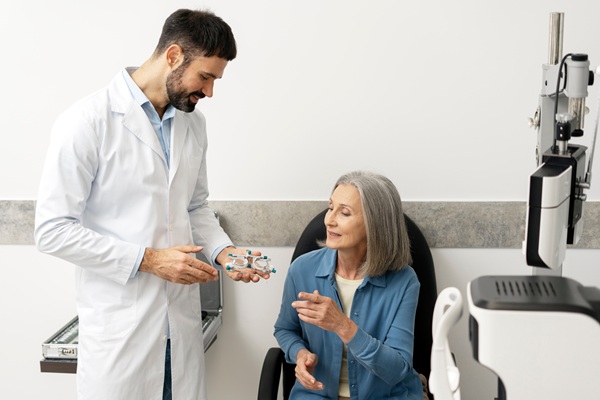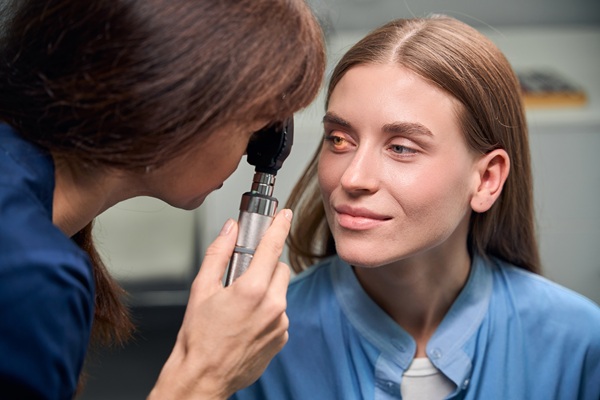How an Optometrist Determines the Right Prescription for You

Getting the right prescription for your eyes is essential for clear vision and overall eye health. An optometrist uses a detailed and systematic process to ensure that your prescription is accurate and tailored to your specific needs. Here is an overview of how an optometrist determines the right prescription for you.
Determining the need for prescription glasses or contact lenses
In many cases, prescription glasses and contact lenses correct refractive errors. These errors occur when the eyes have trouble focusing light correctly due to eyeball length, shape of the cornea, or aging. Common refractive errors include:
- Myopia (nearsightedness)
- Hyperopia (farsightedness)
- Astigmatism (blurred distance and near vision)
- Presbyopia (gradual loss of focus)
When left untreated, refractive errors can impact one's everyday vision and overall quality of life. Fortunately, prescription lens correction can help the eyes better focus light on the retina and improve visual clarity.
The examination process
Visual acuity test
The visual acuity test is the first step in assessing a patient's vision. In this part of the exam, the optometrist asks the patient to read letters from a chart, commonly known as the Snellen chart, positioned at a distance. The patient will need to read out loud as far down and as small as possible.
The visual acuity test results are a basic measure of how well the patient can see at various distances. They are usually represented as a fraction, such as 20/20 or 20/40. This part of the exam can help the optometrist determine the baseline of the patient's vision capabilities and whether they struggle with myopia, hyperopia, or something else.
Refraction assessment
A refraction assessment determines the patient's exact lens prescription. The optometrist uses a device called a phoropter, which contains multiple lenses of different strengths. The patient looks through the phoropter and focuses on an eye chart.
As the patient reads the chart, the optometrist will change the lenses back and forth. They will then ask the patient to compare which lens option makes the letters clearer. This subjective feedback from the patient allows the optometrist to fine-tune the power of the lens needed to correct their vision.
Autorefractor and retinoscopy
In addition to the subjective refraction test, the optometrist may use an autorefractor or perform a retinoscopy for a more objective measure of the patient's prescription. An autorefractor uses light to measure how it changes as it bounces off the back of the eye. This can provide a quick estimation of the necessary prescription.
Meanwhile, a retinoscopy involves shining a light into the patient's eye and observing the reflection of the retina. During this process, the optometrist shines a beam of light from a handheld instrument (retinoscope) and moves it up, down, left, and right. They then hold different lenses in front of the eye, each changing the direction and pattern of the light reflection. The way that the light reflects helps the optometrist gauge whether the patient is nearsighted, farsighted, or has astigmatism.
Binocular vision and eye coordination
An accurate prescription is not only about individual eye clarity but also about how well the eyes work together. The optometrist will assess the patient's binocular vision to ensure that both eyes are aligned and working in sync. This assessment ensures that the two eyes are seeing a single image rather than using one eye at a time. Eye coordination and depth perception tests may include watching how the eyes track moving objects and measuring the distance between the pupils (interpupillary distance). Testing eye coordination can help the optometrist customize the lenses to provide the patient with optimal visual comfort and performance.
Checking eye health
While determining the patient's prescription, the optometrist will also check the overall health of the patient's eyes. This involves a series of tests, such as:
- Slit lamp examination: A microscope with a bright light helps examine the structures at the front of the eye, including the cornea, iris, and lens.
- Tonometry: This test measures the pressure inside the patient's eyes to check for glaucoma.
- Dilated eye exam: By using special eye drops to dilate the pupils, the optometrist can get a better view of the retina and optic nerve at the back of the eye, helping to detect issues like macular degeneration or retinal detachment.
Customizing the prescription
After gathering all the necessary data from the above tests and assessments, the optometrist will finalize the patient's prescription. This prescription will detail the lens power needed to correct refractive errors, the orientation of the lens power, and any additions needed for magnifying power (e.g., bifocals or multifocal lenses), such as reading or close-up work. For patients who wear contacts, their prescription may include the brand of their contact lenses and their parameters, as they sit on the eye and need to be fitted correctly.
Call our office to schedule an appointment
By following the meticulous process above, Texas Optical can ensure you receive the most accurate prescription for your vision needs. Are you due for an updated eyeglass or contact lens prescription? Call our Dallas office to schedule an appointment.
Request an appointment here: https://www.texasoptical.net or call Texas Optical at (214) 771-7333 for an appointment in our Dallas office.
Check out what others are saying about our services on Yelp: Read our Yelp reviews.
Recent Posts
Red, itchy eyes can affect your everyday comfort and reduce overall well-being. It is important to seek effective vision care from the first sign of irritation. Proper attention to symptoms, underlying causes, and healthy habits ensures stronger long-term eye health and greater day-to-day clarity. Redness and itchiness often stem from several common triggers. These include: Allergic…
New spots or shadows drifting across vision can be unsettling, and sudden changes sometimes require emergency eye care to protect long-term sight. Many floaters are harmless, but others signal serious problems with the retina or internal eye structures. Understanding when floaters are normal and when they point to a true eye emergency helps patients act…
Glaucoma treatment plays a vital role in preserving vision and protecting the optic nerve from further damage. Many patients rely on daily eye drops to manage intraocular pressure, but these medications can sometimes come with side effects. Understanding how to recognize, minimize, and communicate about these effects supports long-term success and comfort with treatment. While…
Progressive lenses offer clear vision at near, arm's length, and far distances without the visible lines found in bifocals. They provide a smooth change in power from top to bottom, which means the eyes can focus comfortably throughout the day. With the right fit and guidance from an optometrist, progressive lenses help reduce eye strain…


